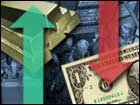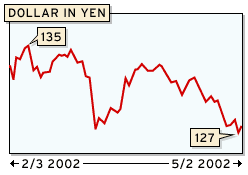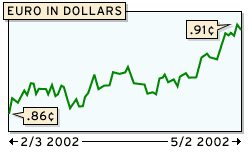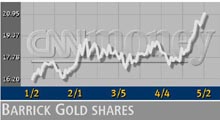
NEW YORK (CNN/Money) -
The mighty have stumbled and the meek have inherited the Earth.
Something like that happened this week in the $1.5-trillion-a-day currency market, which hammered the U.S. dollar, one of the most-clamored for assets over the years. Gold, that perennial cellar-dweller, rose to a new two-year high.
Growing concern about the health of the U.S. economy relative to its overseas counterparts has hurt the dollar, which is down about 6 percent against the yen and euro this year. And two years of sinking stock prices have driven investors into tangible assets considered safe havens, like gold.
But gold's recent shine demands perspective. At $308 an ounce, the precious metal is off sharply from its 1980s peak above $800. It's one of the few investments to lose value over the last 15 years.

And the dollar's recent weakness takes back but a fraction of the currency's gains in recent years, which came as overseas investors snapped up the dollars needed to buy U.S. securities during the bull market. Safety was also a factor as money poured into a country perceived as more stable and less speculative.
Those trends may be ebbing.
"I think what has changed is the market's outlook for the U.S. economy," said Alex Beuzelin, chief market analyst at Ruesch International. "The market is now unsure of the economy's ability to sustain its growth rate beyond the first quarter of the year."

The economy grew at a 5.8 percent rate in the first three months of the year, the strongest pace in more than two years, the government said last week. But economists expect that pace, driven by several one-time factors, to slacken. Recent figures on April consumer confidence and manufacturing have come in weaker than most economists had expected. April's jobless rate rose to its highest level in nearly eight years.
The euro Friday hit a fresh six-month high of 91.67 cents from 90.30 cents Thursday. The dollar fell to a new two-month low of 126.83 yen Friday.
The good and bad
A weaker currency brings pros and cons. It helps companies dependent on exports become more competitive since they can sell goods more cheaply in international markets. In addition, a weak dollar boosts overseas profits when those same companies convert sales abroad into U.S. currency. That's also the case for investors buying international stocks. A soft dollar boosts those returns. And strengthening overseas currencies could draw bargain-seeking tourists to U.S. shores.
But for an import-hungry country like the United States, the weak dollar makes imported goods more expensive, raising inflation. That, in turn, could suffocate the fragile economic recovery that the Federal Reserve, the nation's central bank, is trying to engineer.
Ruesch International's Beuzelin forecast that the dollar could continue to weaken, but not by much. "The fact that the US. economy continues to outperform its European counterparts and Japan will limit the downside," he said.
Japan remains in recession and Europe, he says, does not have the economic efficiencies that currency markets reward.
Like Beuzelin, Marc Chandler, chief currency strategist at HSBC Securities, is betting on short-lived dollar weakness.
"I don't think the dollar is on the verge of a major collapse," said Chandler, who argues that the market will recognize the U.S. economy's heightened productivity.
Reading the tea leaves
More than most other financial instruments, currency fluctuations are among the hardest to predict. Unlike stocks or bonds, which are about buying into a profit or income stream, yen, euro and dollar movements are largely barometers of investors' and currency traders' expectations, shaped more than partly by perception.
"It's more subject to fads, and speculation," said Chandler. "In some ways it's like forecasting the weather."
Shortly after its launch in January 1999, the euro rose as high as $1.19 amid predictions the currency's importance would rival the dollar's. Two years later the euro fell to 83 cents. Forecasters called for the dollar to rise to 165 yen this year. That still could happen, but not any time soon.
Treasury Secretary Paul O'Neill inadvertently waded into the currency market this week. In remarks to Congress Wednesday, he said the Treasury Department's official support for a strong dollar has not changed.
But he also signaled doubts about the effectiveness of government moves to support the currency, suggesting the United States won't try to stop the dollar's recent slide by stepping into international currency markets to buy dollars. Such moves are always risky because government purchases can be ineffective given the huge amounts of currencies traded daily by banks, insurers, companies and other institutions.
The dollar fell following O'Neill's remarks, even though Japan, worried a strong yen will hurt exports, has been trying unsuccessfully for a number of years to weaken its currency.

As for gold, it touched $312 an ounce this week, the highest since February, 2000.
The gains come as investors seek alternatives to stocks. The Standard & Poor's index of 500 largest companies is down about 6 percent this year following two annual losses as Corporate America suffers its worst profit slump in more than 30 years.
Growing doubts about the accuracy of corporate accounting and objectivity of Wall Street research have also lifted gold and other hard assets like real estate. For investors in gold stocks, these are good times. Shares of Newmont Mining (NEM: Research, Estimates) are up 53 percent this year.
But long-time investors have a long way to go until breaking even. Newport shares, for example, would need to rise 82 percent to return to 1997 levels.

|

